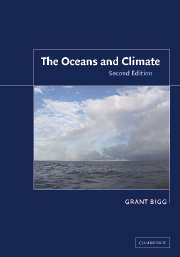Book contents
- Frontmatter
- Contents
- Preface to the first edition
- 1 The climate system
- 2 Physical interaction between the ocean and atmosphere
- 3 Chemical interaction of the atmosphere and ocean
- 4 Biogeochemical interaction of the atmosphere and ocean
- 5 Large-scale air–sea interaction
- 6 The ocean and natural climatic variability
- 7 The ocean and climatic change
- Appendices
- Glossary
- Bibliography
- Index
Preface to the first edition
Published online by Cambridge University Press: 05 June 2012
- Frontmatter
- Contents
- Preface to the first edition
- 1 The climate system
- 2 Physical interaction between the ocean and atmosphere
- 3 Chemical interaction of the atmosphere and ocean
- 4 Biogeochemical interaction of the atmosphere and ocean
- 5 Large-scale air–sea interaction
- 6 The ocean and natural climatic variability
- 7 The ocean and climatic change
- Appendices
- Glossary
- Bibliography
- Index
Summary
In 1827 Jean-Baptiste Fourier, otherwise known for his contributions to mathematics, speculated that human activities had the capacity to affect the Earth's climate. In 1990 the International Panel on Climate Change produced a report detailing our current understanding of these activities, and speculated on what impact they might have on climate. In 160 years of great human endeavour much has been learnt but definitive evidence for climatic change driven by mankind remains elusive.
The oceans play a significant role in this tardiness of the climate system's response to our species. They store immense amounts of energy for months, decades or even centuries, depending on the region, depth and the nature of the interaction between the atmosphere and ocean. This storage capacity acts as a giant flywheel to the climate system, moderating change but prolonging it once change commences. The ocean also stores vast amounts of carbon dioxide.
In 1897 Svante Arrhenius discovered that the amount of carbon dioxide in the atmosphere affected the global temperature through the greenhouse effect. In 1938 G. S. Callendar showed that atmospheric carbon dioxide was increasing due to human activities. However, it has only been since the late 1960s that a rough estimate of the magnitude of the potential climatic effect has been possible. Even today the likely impact of a doubling of atmospheric carbon dioxide on raising global temperature is not known to within 3°C; the global temperature at the height of the last Ice Age was only 4°C less than today.
- Type
- Chapter
- Information
- The Oceans and Climate , pp. ix - xiiPublisher: Cambridge University PressPrint publication year: 2003



